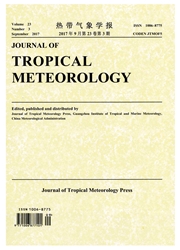

 中文摘要:
中文摘要:
This paper evaluated the performance of a coupled modeling system,Weather Research and Forecasting(WRF)/Urban Canopy Model(UCM),in the simulation of a heat wave event which occurred around Guangzhou during late June through early July,2004.Results from three experiments reveal that the UCM with new land data(hereafter referred to as E-UCM)reproduces the best 2-m temperature evolution and the smallest minimum absolute average error as compared with the other two experiments,the BPA-Bulk Parameterization Approach with new land data(E-BPA)and the UCM with original U.S. Geological Survey land data(E-NOU).The E-UCM is more useful in capturing the temporal and spatial distribution of the nighttime Urban Heat Island(UHI).Differences in surface energy balance between the urban and suburban areas show that low daytime albedo causes more absorption of solar radiation by urban areas.Due to the lack of vegetation which inhibits cooling by evapotranspiration,most of the incoming energy over urban areas is partitioned into sensible heat flux and therefore heats the surface and enhances the heat wave.During nighttime,the energy in the urban area is mainly from soil heat flux.Although some energy is partitioned as outgoing long wave radiation,most of the soil heat flux is partitioned into sensible heat flux due to the small latent heat flux at night.This leads to the development of nighttime UHI and the increase of the magnitude and duration of heat waves within the municipality.
 英文摘要:
英文摘要:
This paper evaluated the performance of a coupled modeling system,Weather Research and Forecasting(WRF)/Urban Canopy Model(UCM),in the simulation of a heat wave event which occurred around Guangzhou during late June through early July,2004.Results from three experiments reveal that the UCM with new land data(hereafter referred to as E-UCM)reproduces the best 2-m temperature evolution and the smallest minimum absolute average error as compared with the other two experiments,the BPA-Bulk Parameterization Approach with new land data(E-BPA)and the UCM with original U.S. Geological Survey land data(E-NOU).The E-UCM is more useful in capturing the temporal and spatial distribution of the nighttime Urban Heat Island(UHI).Differences in surface energy balance between the urban and suburban areas show that low daytime albedo causes more absorption of solar radiation by urban areas.Due to the lack of vegetation which inhibits cooling by evapotranspiration,most of the incoming energy over urban areas is partitioned into sensible heat flux and therefore heats the surface and enhances the heat wave.During nighttime,the energy in the urban area is mainly from soil heat flux.Although some energy is partitioned as outgoing long wave radiation,most of the soil heat flux is partitioned into sensible heat flux due to the small latent heat flux at night.This leads to the development of nighttime UHI and the increase of the magnitude and duration of heat waves within the municipality.
 同期刊论文项目
同期刊论文项目
 同项目期刊论文
同项目期刊论文
 期刊信息
期刊信息
